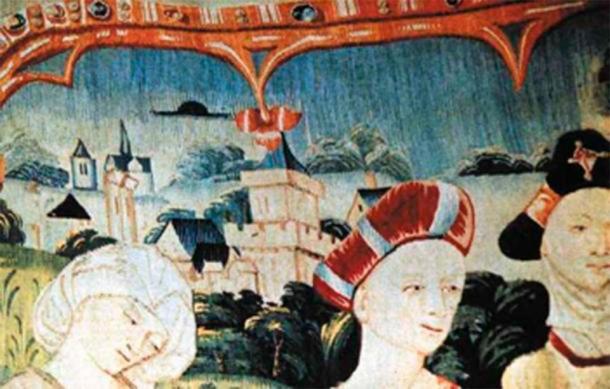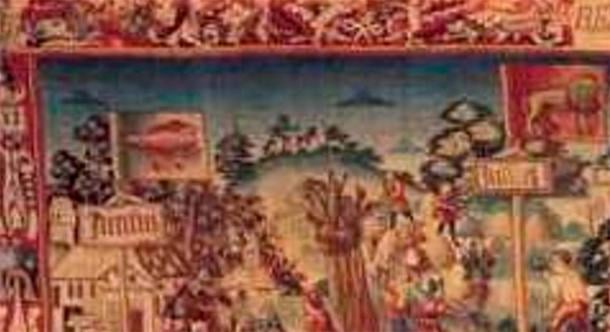The Enigma of Disc-Shaped Objects in Summer's Triumph Tapestry
In 1538 AD a tapestry was created in the city of Bruges in Belgium, known as the Summer’s Triumph. It depicts the victorious ascension of a ruler to power. However, there is something far more modern interest depicted in the tapestry, which would be easy to miss unless you were looking closely - multiple objects in the sky, which have the classical UFO shape that is popularized in the media.
Exploring the Bruges Summer’s Triumph Tapestry
This tapestry was crafted in Bruges in 1538 and is now housed in the Bayerisches National Museum. The city of Bruges is the capital and the largest city of the province of West Flanders in the Flemish Region of Belgium in the northwest of the country. The origins of the city go back to the pre-roman Era and it has been the target of many invasions because of its strategic location.
- Ancient Artists Left Signs For us to Decode. Did they Witness UFOs?
- The Legendary Isle of Es Vedra: Atlantis, The Odyssey and a Magnetic Attraction for UFO Sightings
The “Sky of the Summer’s Triumph Tapestry” is a poetic and vivid expression that conjures images and emotions associated with the zenith of summer. If you look at the top of the tapestry, especially towards the left-hand side, it is possible to see a number of ‘hat shaped’ flying objects in black – that are not related to any religious depictions that are frequently seen in the sky in other medieval artworks.

Life of the Virgin Mary, medieval tapestry from Tournai, Belgium. (Notre Dame Basilica Beaune / Public Domain)
In a previous Ancient Origins article we discussed the Mysterious Medieval Tapestries such as the “Life of the Virgin Mary”, medieval tapestry from Tournai, Belgium or the “Magnificat," created in 1330, this portraying an enigmatic black object in a manner reminiscent of common characteristics seen in numerous UFO sightings. Both housed at the Notre Dame Basilica in Beaune France, both tapestries depict a singular unidentified flying object, gracefully moving through the background sky.
A Political Strategy or Divine Intervention?
The upper portion of the tapestry prominently features several disc-shaped objects in the sky. The deliberate inclusion of "hat ships" in this artwork could be interpreted as a strategic political maneuver. By associating UFOs with the reigning authorities, the intention might have been to influence local sentiment and assert a divine connection, thereby reinforcing the idea of celestial intervention in their rise to power.
Some historians have suggested that these objects represent the significance of this ruler coming to power and that he had the support of the ‘divine’. But since when are flying disc shaped objects considered as a symbol of divine intervention? And if they are, why?
If the people in that era associated flying saucers with divinity, it means they were seeing such objects in the sky and linking them to a ‘godly’ phenomena. Of course on the other hand there are those who have claimed that these unusual hat-shaped objects are simple strangely-shaped dark clouds…
- Wandering Sky Gods: The Personification of Astronomical Phenomena in Ancient Times
- UFO Author Will Lead Exploration of Rendlesham Forest Encounters Site

Various disc-shaped objects can be observed on the top left side of the tapestry. (Sirusly)
This tapestry is stored in the Bayerisches National Museum on extended loan from the HypoVereinsbank UniCredit Bank AG. The museum has no other information regarding the tapestry's history.
Top image: Summer’s Triumph Tapestry, 1538. Source: Sirusly
By John Black


















Comments
Everyone talks about the ufo's bug look the first flagg it's An airplane. I AM sure they weren't arround at 1538.
They almost look like upside down sake cups. So I thought, is there a possible Japanese connection? I started researching Japanese history and I found out some interesting facts that might be relevant. Turns out that the Japanese were the original inventors of the waffle. Not the Belgians.
Ancient Japan used to known as the kingdom of "Wa". Which apparently is where the word waffle comes from. Sometime in the late 13th century Japan invaded Belgium by accident. They thought they were invading Argentina but due to erroneous navigation ended up in Europe.
The Belgians, being used to invasions, accepted the situation. Wine was outlawed and only sake was available. Japan left after only a few years due to the lack of basic Japanese necessities. Such as rice, baseball and squid sperm. The Belgians immediately restored wine consumption and banned sake to this day.
The upside down sake cups might be a form of protest. Also, the original Mannekin Pis fountain used to whiz into a sake cup. But in the 1970's Japan finally found out and threatened to invade again. So the Belgian government removed the cup and replaced it with a Pisco bottle. The Peruvian Government has filed numerous protests.
One other thing, I recently saw on Ebay an old waffle iron for sale in Belgium that had on it "Made In Japan". Coincidence?
Thanks, I agree.
Your reply is gibbirish! The town Bruges (Brugge) in what is now Belgium was once a center of tapestry and well know and appreciated for it's art and quality far and beyond. Furthermore you make it sound like "the artist" discovered it's first crayon and attempted to draw clouds. Come on, these artist were often the pupils of Van Dijk and Breugel and they knew very well how to depict clouds, islands or whatever. So why can't it be UFO's, as seen in other tapestry and also witnessed and documented in those ages?
Lenticular clouds. They often appear over mountains, which you might notice these "flying(?) hat-shaped objects" appear over.
Pages